#component-driven
Explore tagged Tumblr posts
Text
Exploring Component-Based Architecture in NextJS
Unlocking the Power of Component-Based Architecture Component-based architecture is a powerful approach in modern web development that allows for modular, reusable, and scalable code. With frameworks like NextJS, developers can leverage the benefits of component-based architecture to build efficient and maintainable web applications. What is Component-Based Architecture? In component-based…
#component-based architecture#component-driven#efficient frontend development#Frontend Development#NextJS#NextJS component-based architecture#React#scalable web development#web development
0 notes
Text
Been working on another Elden Ring breakdown of notable observations in a specific location. With all the corpses strewn about, sometimes it feels like solving a murder mystery, or in general some other kind of "whodunit" puzzle. Then I remembered that the story trailer for Elden Ring has always pointed at basically that.
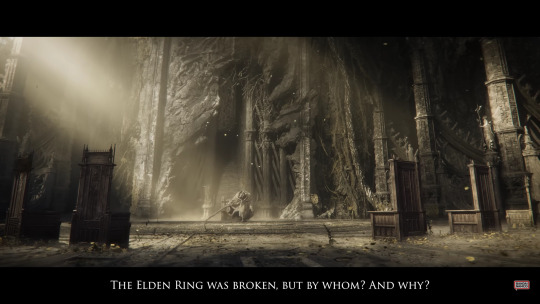
Means, motive, and opportunity are the three main indicators of suspicion for an investigation. For the breaking of the Elden Ring in particular we are told the means explicitly just for making it to the end: Marika's Hammer. We are also told in the item description who did it: Marika. In this way bypassing the need to guess a perpetrator based on opportunity. So all that remains is the motive.
That is what the game is asking the players to do. Maybe even more specifically, this is what Ranni is asking the players to do. Review all of the evidence scattered throughout the Lands Between to figure out Marika's motive for Shattering the Elden Ring.
It's a "whydunit" story.
#elden ring#media analysis#figuring out why any of the demigods were driven to fight and kill in the shattering war is another component to the story#their reasons are all tied to Marika's motive anyways#stuff like this is why I roll my eyes at people who say there is no story - a murder mystery investigation is a type of story#writers need to know the motivations of their characters but they don't always directly tell the reader in simple terms what these are#motivations are complicated and a product of history
16 notes
·
View notes
Text
Anyway I’ve been very emotional about getting comments on how I write lady characters despite my clear and obvious fondness for male characters like you cannot stop me from taking an underloved, underutilized female character and doing insane things with her. I’ve been doing this since I was writing Penelope Widmore fanfics on LJ. I love female characters goddammit.
#like Roseverse is intentionally a very female-driven story for all that many of the focal characters are men#but it’s true of LitMoR too like even getting past Cree#how much of the story is dedicated to SPECIFICALLY female characters#even when they’re not in the Nein#like god even Jayne’s stuff with Ashley is a very specific kind of female dragon to the villain narrative#twisted on its head#my writing#unfortunately this is also a huge component of my Seanan McGuire brainrot#life in the margins of redemption#red roses and dead things
7 notes
·
View notes
Text
remember when matpat was like "BY THE AMOUNT OF MINIMUM WAGE MIKE IS MAKING WE CAN DEDUCE THIS GAME TAKES PLACE IN 1987" youre fucking INSANE dude. THE CHECK LITERALLY SAID "20XX" ON IT
#ooc#it makes me so. ggh.AAAHHHHHH#I CANT ARTICULATE WHY IT MAKES ME SO MAD#BUT IM GOING TO TRY#FNAF THEORIES ARE ALWAYS FOCUSED ON THE LOGISTICS OF THE SERIES AND WHAT 'MAKES SENSE' FOR THE TIME PERIOD AND WHAT MAKES SENSE AS PER NUMB#NUMBERS** AND I THINK THIS IS PROBABLY BECAUSE MATPAT HIMSELF DOES NOT THEORIZE IN A FICTIONAL META FANTASY WAY#MATPAT TAKES FANTASY FICTIONAL STORIES AND TRIES TO APPLY REAL LIFE LOGIC AND MATH TO IT TO MAKE SENSE OF IT#WHICH IS OKAY. GO RIGHT AHEAD. DO THAT#BUT THAT IS NOT WHAT *FIVE NIGHTS AT FREDDYS* IS ABOUT AND I DOUBT IT WAS A COMPONENT SCOTT CAWTHON WAS FUCKING WORRIED ABOUT WHEN WRITING#THE STORY CONSIDERING 99% OF SCOTTS INTIIAL WORK WAS FANTASTICAL RIDICULOUS COMEDY FANTASY SHIT ABOUT TALKING COFFEE POTS#AND JESUS!!!!!!!!!!! LIKE. BONAFIDE JESUS!!!!!!!!! I DONT THINK THIS GUYS DOING THE FUCKING MATH FOR HIS FICTIONAL STORIES#I THINK SCOTT CAWTHON LIKE *MOST OTHER ARTISTS WHO TELL STORIES ABOUT SHIT LIKE THIS* CARED MORE ABOUT THE EMOTIONAL REACTIONS THEN THE#LITERAL FUCKING MATH OF THE YEARS OR THE DATES OR THE PAYCHECKS OR THE FUCKING ANIMATRONICS PISTONS#okay yelling moment over im not actually that mad im just really impassioned#i love art. i love fictional stories. i love emotionally driven stories. i love abstraction. i love symbolism. the game is full of it!#but i feel like when you sit there and argue with the story *itself* about what its about youre missing the point of the story at all#and youre missing the forest for the trees my man
18 notes
·
View notes
Text
everybody thinks they have the best tabletop campaign but actually me and my friends are doing it better than it's ever been done.
#we are in a STATE right now. jane is 1) a vampire. 2) in love. 3) possessed. 4) taking warlock levels.#a new character just joined in who is somehow accidentally EXACTLY the culmination of every single one of#the fears jane's mentor made very sure were driven home when she started teaching her necromancy.#AND her mentor is maybe in her eye? maybe opening a door in her eye? maybe going to explode her head?#dr aravis you are so toxic but also really pretty hot. sorry about the eye thing#glance now over the wrong shoulder#what if your sith mentor/grad school advisor was also a gilf...#and she taught you things but never enough to quench your thirst for knowledge or attention. BUT enough to blackmail you with#in case she ever needed a lever on you. yeah. also they really need to audit the wizard university finances.#because jane was truly spending THOUSANDS on components. and for what.
4 notes
·
View notes
Text
Europe Aircraft Leasing Market: Rapid Development and Value Trends Forecast (2024-2032)

The Europe Aircraft Leasing Market is on a trajectory of rapid development, driven by evolving value trends and a robust aviation sector. As European airlines and operators navigate the complexities of fleet management, leasing has emerged as a strategic solution to meet both current and future needs.
Europe Aircraft Leasing Market showcases the following key aspects:
Fleet Expansion and Modernization: European airlines are increasingly turning to leasing to expand and modernize their fleets. This approach allows them to quickly integrate new aircraft models that enhance operational efficiency and comply with environmental regulations.
Economic Uncertainty and Flexibility: Leasing provides airlines with greater financial flexibility amid economic uncertainties. It allows operators to manage capital expenditure more effectively and adjust their fleet size according to market demand.
Technological Advancements: The adoption of advanced technologies in leased aircraft supports better fuel efficiency and lower emissions. European airlines benefit from these innovations without the long-term financial commitment of owning the aircraft.
Regulatory Pressure: Europe’s stringent environmental regulations drive the demand for modern, eco-friendly aircraft. Leasing offers a practical solution for airlines to meet these requirements while minimizing financial risk.
Geographical Distribution: Key markets in Europe, such as the UK, Germany, and France, are at the forefront of the leasing trend. Their well-developed aviation sectors and strategic positions contribute to the overall growth of the market.
The forecast for the Europe Aircraft Leasing Market is characterized by robust growth and ongoing development. As airlines continue to seek flexible and cost-effective solutions, leasing will remain a vital component of the region’s aviation landscape.
About US
At Market Research Future (MRFR), we enable our customers to unravel the complexity of various industries through our Cooked Research Report (CRR), Half-Cooked Research Reports (HCRR), Raw Research Reports (3R), Continuous-Feed Research (CFR), and Market Research & Consulting Services. MRFR team have supreme objective to provide the optimum quality market research and intelligence services to our clients. Our market research studies by products, services, technologies, applications, end users, and market players for global, regional, and country level market segments, enable our clients to see more, know more, and do more, which help to answer all their most important questions. To stay updated with technology and work process of the industry, MRFR often plans & conducts meet with the industry experts and industrial visits for its research analyst members.
Contact us:
Market Research Future (part of Wants tats Research and Media Private Limited),
99 Hudson Street,5Th Floor, New York, New York 10013, United States of America
Sales: +1 628 258 0071 (US) +44 2035 002 764 (UK)
Email: [email protected]
#The Europe Aircraft Leasing Market is on a trajectory of rapid development#driven by evolving value trends and a robust aviation sector. As European airlines and operators navigate the complexities of fleet managem#leasing has emerged as a strategic solution to meet both current and future needs.#Europe Aircraft Leasing Market showcases the following key aspects:#•#Fleet Expansion and Modernization: European airlines are increasingly turning to leasing to expand and modernize their fleets. This approac#Economic Uncertainty and Flexibility: Leasing provides airlines with greater financial flexibility amid economic uncertainties. It allows o#Technological Advancements: The adoption of advanced technologies in leased aircraft supports better fuel efficiency and lower emissions. E#Regulatory Pressure: Europe’s stringent environmental regulations drive the demand for modern#eco-friendly aircraft. Leasing offers a practical solution for airlines to meet these requirements while minimizing financial risk.#Geographical Distribution: Key markets in Europe#such as the UK#Germany#and France#are at the forefront of the leasing trend. Their well-developed aviation sectors and strategic positions contribute to the overall growth o#The forecast for the Europe Aircraft Leasing Market is characterized by robust growth and ongoing development. As airlines continue to seek#leasing will remain a vital component of the region’s aviation landscape.#About US#At Market Research Future (MRFR)#we enable our customers to unravel the complexity of various industries through our Cooked Research Report (CRR)#Half-Cooked Research Reports (HCRR)#Raw Research Reports (3R)#Continuous-Feed Research (CFR)#and Market Research & Consulting Services. MRFR team have supreme objective to provide the optimum quality market research and intelligence#services#technologies#applications#end users#and market players for global#regional
0 notes
Text
scrolling thru my own goddamn belgariad fan blog, going thru the character tags while looking like this

#the belgariad#zakath you bastard.... i..love youyyyuu#...hhhh#beldin why are you so...funny#why are you aldur brothers so! rrahh the dynamics at play are Delectable!#throwing up....#polgara and belgarath love each other so much im reading the beginning of pawn of prophecy and feel like crying#they love each other so much!#and they're all so fucking funny....#but im thinking mainly about zakath rn#he's so fucking sopping wet#i wish the term poor little meow meow had existed when i read these books... he's so fucking poor.. and he has several meow meows... i think#there are so many characters! that ive put in the posts on that blog! how could i ever remember all their names and their fun little tidbits#one day i will return to that glory.... i will know all of it... and then you'll see#then you'll all see#i watched the vine compilations i posted on youtube back in the day too#damn..urgit... i haven't heard that name in years#thinking about silk too.... oh boy they're perfect#urgit is genuinely so great#oh god and relg too! i love relg#i love every goddamn character in these books but not as much as i love the story driven narrative and characters without agency#and the world building boiled down to its base components#cliches and tropes simplified and reverted and flipped and indulged... it's such a fun world and such a fun story#and i love every single character#and the plot#and the cozy feeling of always already knowing what to expect feom the plot. and how the 4th wall is almost broken in that way#with the prophecies ruling their lives and actions.... predeterminism..... they're just characters. but they're ao funny about it#eddings is so funny tbh.... the dialogue is elite#hhhhrhhrhhhhhhhhhAA#pickapost
1 note
·
View note
Text
Event-Driven Design Demystified: Concepts and Examples
🚀 Discover how this cutting-edge architecture transforms software systems with real-world examples. From e-commerce efficiency to smart home automation, learn how to create responsive and scalable applications #EventDrivenDesign #SoftwareArchitecture
In the world of software architecture, event-driven design has emerged as a powerful paradigm that allows systems to react and respond to events in a flexible and efficient manner. Whether you’re building applications, microservices, or even IoT devices, understanding event-driven design can lead to more scalable, responsive, and adaptable systems. In this article, we’ll delve into the core…

View On WordPress
#Asynchronous Communication#Decoupling Components#E-commerce Order Processing#Event Broker Paradigm#Event Sources and Consumers#Event-driven architecture#Event-Driven Examples#Event-Driven Paradigm#Event-Triggered Workflows#Microservices and Events#Middleware in Event-Driven Design#Modular Development#Reactive Systems#Real-Time Responsiveness#Scalable Software Systems#Smart Home Automation#Social Media Notifications#Software Design Patterns#System Event Handling#User Experience Enhancement
1 note
·
View note
Text
In an inspiring return 200 years in the making, the last truly wild horse species has been reintroduced onto the open steppes of Kazakhstan.
The Guardian reports that four mares from a breeding program in Berlin and a stallion and two other mares from Prague, were flown to the Central Asian country to mark the second successful reintroduction of Przewalski’s horse to the lands that above all others are associated with this beloved animal.
At an unspecified place on the Eurasian Steppe around 6,000 years ago, of which Kazakhstan is a major component, human beings domesticated the horse. It changed history forever...
In 2011, Prague Zoo was also involved in a reintroduction of Przewalski’s horses to Mongolia which continued for 8 years until the population stabilized. There are now 1,500 such horses in the country.
The Kazakhstan reintroduction comes on the back of several environmental success stories driven by a passionate environmental movement in the country. This has included the reintroduction of Bukhara deer around the shores of Lake Balkhash, and the continued legislative and conservation efforts to restore the majestic saiga antelope, which have resulted in a growth of the population to 1.9 million.
-via Good News Network, June 12, 2024
#horse#horses#przewalski's horse#endangered species#conservation#biodiversity#rewilding#kazakhstan#central asia#steppes#good news#hope
1K notes
·
View notes
Text

V-belt used for? V-belts are belts with a trapezoidal cross-section. Like other types of belts, they are used to transmit power or torque from the driving component to the driven component. V-belts get their name from their trapezoidal shape, which helps them wedge into the sheaves. Twisted synthetic fibrous tensile chords, compressed by synthetic rubber form a typical V-belt, rendering it strength and flexibility. A v-belt is a flexible machine element used that transmits power between a set of grooved pulleys or sheaves. They are characterized by their trapezium cross-section. V-belts are used because of their ability to wedge tightly into the grooves of the pulley.
#bestindustry#bestoffers#OnTimeDelivery#bestprice#goodservice#donateorgansavelives#Hi-Tech Automation#DrugFreeIndia#vbelts#V-belt used for?#V-belts are belts with a trapezoidal cross-section. Like other types of belts#they are used to transmit power or torque from the driving component to the driven component.#V-belts get their name from their trapezoidal shape#which helps them wedge into the sheaves. Twisted synthetic fibrous tensile chords#compressed by synthetic rubber form a typical V-belt#rendering it strength and flexibility.#A v-belt is a flexible machine element used that transmits power between a set of grooved pulleys or sheaves. They are characterized by the
0 notes
Note
I'm going to be asking a lot of artists I follow this question, but how did you develop your style? It SEEMS like most people find their style and stick with it forever, just making improvements and iterations. I tend to work in a lot of different styles because I enjoy doing that, though I know there are things I gravitate towards as well. But I wonder what your journey was and how you got feedback and improved while staying true to what you enjoyed?
Hi there!
I definitely wouldn't say that I've found my style and stuck with it forever-- I feel like each of my projects has asked for a certain kind of art, and has presented new challenges that push me in new directions.
Some of that comes from seeing someone else's work and having something click into place that might fix errors/faults in my own, and then I might try to incorporate that, such as bigger outlines on my characters to help distinguish them from the background, or maybe a way someone else simplifies eyes that can help make mine look less weird.
When I first started drawing, I can see where I encountered certain influences because my sketchbooks suddenly switch to incorporating some new stylistic element that I liked from whatever I was reading/watching at the time. But it was never QUITE right, it was never just copying, there was always something ~wrong~ with it. And that wrongness was my style! As much as I hated it, that was what distinguished my art from being just a copy of someone else's. I hate it less now, and understand that other people see something there that maybe I don't, because it's just what happens when I filter other people's work through my head. My soul, if you will.
There are definitely through-lines with my work, driven by what I like drawing and what comes easily to me-- hatching is almost always a major component, and I like making expressive characters. Here's some of my earliest available stuff, from my old webcomic:

Then not long after that, I started The Last Halloween, which pushed me to challenge myself in both layout and style:

And here's the same comic, years later:

And here's a series I did for kids, where I had to use full color and lay off on the hatching, as well as learn how to reconstruct animals that we have no photo references for, which is definitely a place where style comes majorly into play, whether I wanted it to or not:
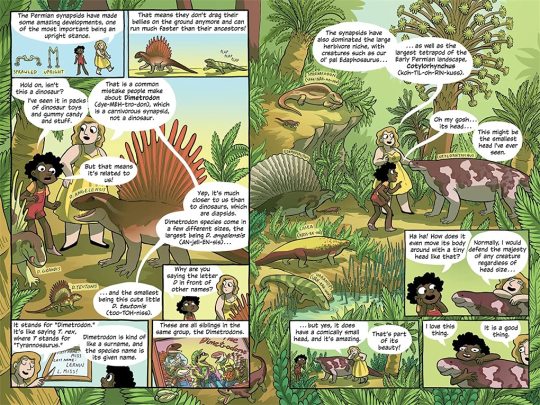

Then there was the horror book I did, where I tried to push my work to be less cartoony overall, and to work very hard on improving my hatching:
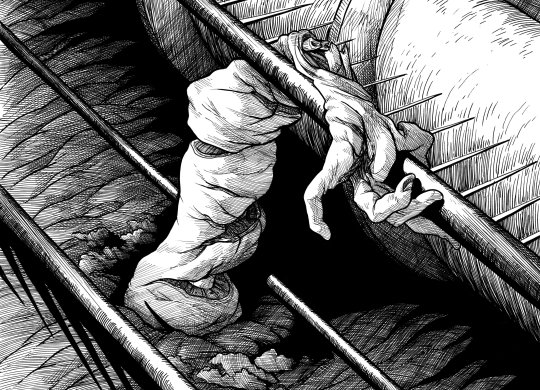
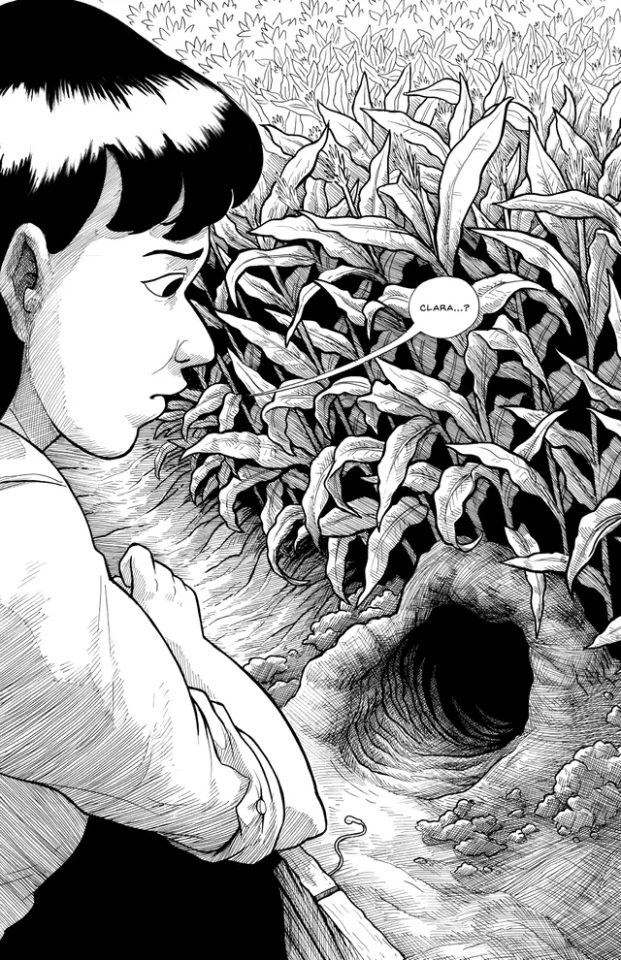
Then I started work on Scarlet Hollow, where I incorporated a limited/muted palette and had to once again push myself to make less-cartoony art, as well as learn more consistency so I could draw sprite sets. This was a big challenge for me, and has helped me grow as an artist so much!
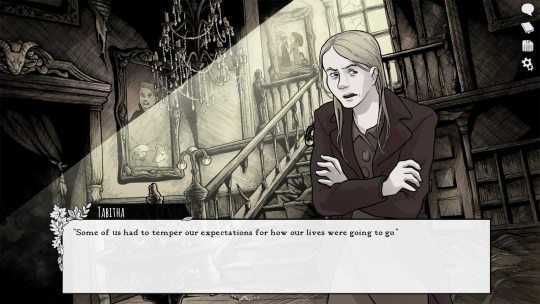
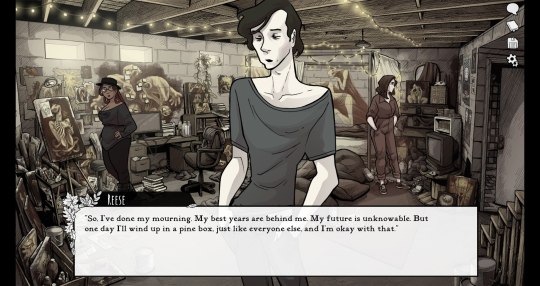
And most recently, I wrapped up work on Slay the Princess, which required that I go back in the cartoony direction, but in a very different way than I was used to. This took a lot of sketching to figure out, and there's still a decent amount of artistic stumbling in Chapter 1 while I settled into it.
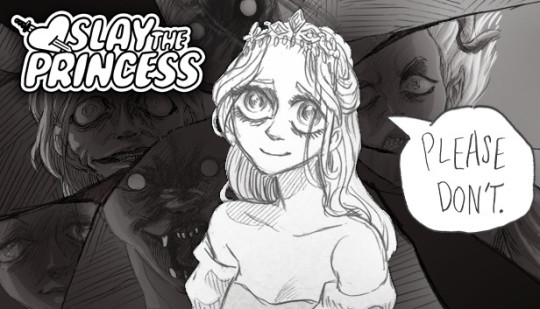
She's drawing on anime/Disney influence, but each Princess required a bit of stylistic variability. Some are more anime, while some are more realistic than even the Scarlet Hollow characters.
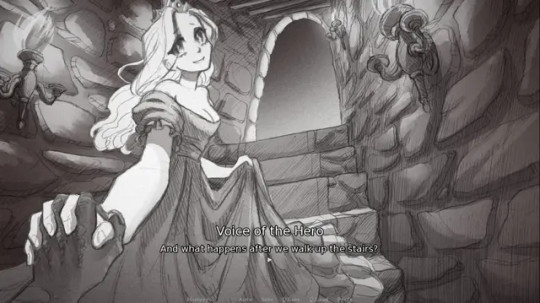

So I wouldn't worry too much, honestly! A person's style is often something that reveals itself over the course of their career, rather than something they choose and then try to stick to forever.
Even if you don't think you have a style, you do. It might vary a lot piece by piece, especially if you're trying to closely imitate another person's art, but the more work you do, the more you'll figure out your own strengths and interests!
#long post#my art#junior scientist power hour#the last halloween#abby howard#scarlet hollow#slay the princess#once you work long enough on art#style starts to feel more like modes you switch in and out of#all based around a core of what you're good at and what you can do#which in itself will change sometimes!#and of course your style with different mediums is gonna be different too#like slay the princess is pencil which is why it looks more distinct from my other work#never forget that at its core art is about messin around#wait shoot i should've put all this in the post#but it's long enough as it is
407 notes
·
View notes
Text
adventures in aerospace
So I recently started working at Large Aircraft Manufacturer. (LAM) The plant I work at employs 30,000 people. The company as a whole employs 170,000. Usually you only hear about LAM when something goes wrong. But no matter how bumbling it seems from the outside, it's way worse on the inside.
Three months after my first day, I have been "graduated" from "training." In reality, I'm still completely worthless on the floor: the training center has given me a paltry subset of the production certificates I need to actually to do my assigned job. A commonly cited statistic at LAM is that a hundred men a day are retiring, each one representing decades of experience, walking out the door, forever. The training center is in the unenviable position of managing a generational replacement, and have resorted to shoveling heaps of zoomers through as fast as possible. (As one of the few people with a visible hairline and who is not wearing a Roblox graphic tee; I am frequently mistaken for an instructor, and asked where the bathroom is, what time the next class starts, etc)
In theory, the training center knows what shop I'm assigned to, and can simply assign me all the required classes. In practice, they do the absolute minimum amount of training in a desperate attempt to relive the crowding in their handful of computer labs and tell graduates to pick up their certs later.
Of course, the irresistible force of the schedule meets the immovable object of the FAA. If you don't have the required production certificate to perform a particular job, you don't touch the airplane. Full stop, end of story.
And so the curtain opens on the stage. It reveals a single senior mechanic, supervising a mechanic who finally received all the certs and is being qualified on this particular job, surrounded by another three trainees. Trainees are less than nothing, absolute scum. At best we can fetch and carry. Mostly we are expected to stay out of the way. And the senior mechanic is only senior in title. He is one of six assembler-installers who is certified to actually work on the plane, out of twenty people on the crew, and spends every day with a permanent audience. He is 23 years old.
("Mechanic"? If you think the jargon at your job is bad, try joining a company that's a century old. Assembler-installers are universally referred to as "mechanics", despite doing work that's nothing like what a car mechanic does, and who are generally paid far worse than FAA certified A&P mechanics. Mechanics are the 11 bravos of LAM, grunts, the single largest category of worker. The tip of the spear. Hooah!)

Large Aircraft Manufacturer is in a dilly of a pickle. All of its existing airframe designs are hilariously antiquated. It tried designing a brand new plane from a clean sheet, and lost billions of dollars to a decade-long integration hell. After that, to save money, it tried just tacking bigger engines on an older design without changing anything else, and the stupid things plowed into the ground in an excruciatingly public manner.
LAM is now trying a middle road. It is upgrading one of its designs that is merely middle aged, rather than ancient, and with proven, de-risked components built in-house, rather than scattering them to subcontractors across the world. And it's still blowing past deadlines and burning billions of dollars LAM really doesn't have to spare.
This is the program I've been assigned to.
Advanced Midbody - Carbon Wing has taken the bold step of just tacking on carbon fiber wings to a conventional aluminum fuselage. Shockingly, AMCW is now stuck in lightning strike testing, due to that troublesome join between conductive aluminum and conductive...ish carbon fiber. But LAM, confident as ever, or perhaps driven by complaints of its customers, has announced that full rate production will begin just next year. Thus the tide of newhires. According to the schedule, we're supposed to jerk from one wingset a month to one wingset a week. That's not going to happen, but, oh well, orders from above move down at the speed of thought, while reality only slowly trickles upwards.
"120 inch pounds? Really?"
I startle upright. I have observed one hundred pi bracket installs, and I will observe a hundred more before I can touch aircraft structure. This is the first disagreement I've witnessed. A more advanced trainee is questioning the torque spec on a fastener. It is not an entirely foolish question-- most sleeve bolts we use are in the 40 in-pounds range. Doubling it that is unusual. I cough the dust off my unused vocal cords and venture an opinion.
"Well hey I could look it up? I guess"
The lead mechanic glances at me, surprised that I'm still awake, then looks away. Excuse enough for me!
I unfold myself from the stool I've been sitting on for the last four hours then hobble over to the nearest Shared Production Workstation.
We do not get Ikea-style step by step instructions on how to put together the airplane. Like any company that's been around for long enough, LAM is a tangled wad of scar tissue, ancient responses to forgotten trauma. If you state a dimension twice, in two different places, then it is possible for an update to only change one of those dimensions, thereby making the engineering drawing ambiguous. Something real bad must have happened in the past as a result of that, so now an ironclad rule is that critical information is only stated once, in one place, a single source of truth.
As a result, the installation plan can be a little... vague. Step 040 might be something like "DRILL HOLE TO SIZE AND TORQUE FASTENERS TO SPEC". What hole size? What torque spec?
Well, they tell you. Eventually.

(Image from public Google search)
You are given an engineering drawing, and are expected to figure out how things go together yourself. (Or, more realistically, are told how it's done by coworkers) Step by step instructions aren't done because then dozens of illustrations would have to be updated with every change instead of just one, and drawings are updated surprisingly frequently.
Fasteners are denoted by a big plus sign, with a three letter fastener code on the left and the diameter on the right, like so: "XNJ + 8"
To get the actual part number, we go to the fastener callout table:

(Note the use of a trade name in the table above. There is nothing a mechanic loves more than a good trademark. Permanent straight shank fasteners are always called HI-LOKs™. It's not a cable tie, it's a Panduit™. It's not a wedgelock, it's a Cleco™. Hey man, pass me that offset drill. What, you mean a Zephyr™? Where'd the LAMlube™ go? This also means you have to learn the names of everything twice, one name on the installation plan, and one name it's referred to in conversation.)
We find XNJ on that table, and fill in the diameter: BACB30FM8A. Now we look up the spec table for that fastener:

The eagle eyed among you might note that there is no "diameter: 8" on that table. As a LAM mechanic, you are expected to simply know that "diameter" is measured in 32nds of an inch, which simplifies down to 1/4.
(LAM preserves many old-school skills like fraction reduction and memorizing decimal equivalents like this, like flies caught in amber. Not least is the universal use of Imperial units. Many American manufacturers have been browbeaten into adding parenthetical conversions. Not LAM! Any risk at all of a mechanic seeing a second number and using it by accident is too great, and anyway, it violates SSOT. Lengths are in inches and feet, weights are in pounds, volume is in gallons and if you don't like it then you can go eat shit!)
After 10 minutes of following references, I arrive at that table, print it off, highlight the correct row, and hand it off to my senior mechanic.
"Great, thanks."
Gratified that I have enhanced shareholder value, I sit back down, and immediately fall asleep. Another day living the dream.
(next post in this series)
415 notes
·
View notes
Text
Writing Notes: Emotions

Definitions in Psychology (Anger; Anticipation; Anxiety; Contempt; Desire; Disgust; Distress; Fear; Guilt; Happiness; Interest; Joy; Pain; Pleasure; Rage; Sadness; Shame; Sorrow; Surprise; Terror; Wonder)
Anger
An emotion characterized by tension and hostility arising from frustration, real or imagined injury by another, or perceived injustice.
Can manifest itself in behaviors designed to remove the object of the anger (e.g., determined action) or behaviors designed merely to express the emotion (e.g., swearing).
Distinct from, but a significant activator of, aggression, which is behavior intended to harm someone or something. Despite their mutually influential relationship, anger is neither necessary nor sufficient for aggression to occur.
Anticipation
Looking forward to a future event or state.
Sometimes with an affective component (e.g., pleasure, anxiety).
Anxiety
An emotion characterized by apprehension and somatic symptoms of tension in which an individual anticipates impending danger, catastrophe, or misfortune.
The body often mobilizes itself to meet the perceived threat:
Muscles become tense, breathing is faster, and the heart beats more rapidly.
May be distinguished from fear both conceptually and physiologically, although the two terms are often used interchangeably.
Considered a future-oriented, long-acting response broadly focused on a diffuse threat, whereas fear is an appropriate, present-oriented, and short-lived response to a clearly identifiable and specific threat.
Contempt
An emotion characterized by negative regard for anything or anybody considered to be inferior, vile, or worthless.
Desire
A strong feeling of wanting or needing something.
Can be a motivating force that drives behavior and influences decision-making.
Can be related to a wide range of things, such as material possessions, experiences, relationships, or personal goals.
Often considered to be an emotion, and it can be accompanied by physical sensations such as an increased heart rate or butterflies in the stomach.
However, it can also be more cognitive in nature, driven by thoughts and beliefs rather than just emotional reactions.
Disgust
A strong aversion.
For example, to the taste, smell, or touch of something deemed revolting, or toward a person or behavior deemed morally repugnant.
Distress
A negative emotional state in which the specific quality of the emotion is unspecified or unidentifiable.
For example, stranger anxiety in infants is more properly designated stranger distress because the infant’s negative behavior, typically crying, allows no more specific identification of the emotion.
Fear
A basic, intense emotion aroused by the detection of imminent threat, involving an immediate alarm reaction that mobilizes the organism by triggering a set of physiological changes.
These include rapid heartbeat, redirection of blood flow away from the periphery toward the gut, tensing of the muscles, and a general mobilization of the organism to take action.
Fear differs from anxiety in that the former is considered an appropriate short-term response to a present, clearly identifiable threat, whereas the latter is a future-oriented, long-term response focused on a diffuse threat.
Some theorists characterize this distinction more particularly, proposing that fear is experienced when avoiding or escaping an aversive stimuli and that anxiety is experienced when entering a potentially dangerous situation (e.g., an animal foraging in a field where there might be a predator).
Whatever their precise differences in meaning, however, the terms are often used interchangeably in common parlance.
Guilt
A self-conscious emotion characterized by a painful appraisal of having done (or thought) something that is wrong and often by a readiness to take action designed to undo or mitigate this wrong.
It is distinct from shame, in which there is the additional strong fear of one’s deeds being publicly exposed to judgment or ridicule.
Happiness
An emotion of joy, gladness, satisfaction, and well-being.
Interest
An attitude characterized by a need or desire to give selective attention to something that is significant to the individual:
Such as an activity, goal, or research area.
Joy
A feeling of extreme gladness, delight, or exultation of the spirit arising from a sense of well-being or satisfaction.
The feeling of joy may take two forms: passive and active.
Passive joy involves tranquility and contentment with things as they are.
Active joy involves a desire to share one’s feelings with others. It is associated with more engagement of the environment than is passive joy.
The distinction between passive and active joy may be related to the intensity of the emotion, with active joy representing the more intense form.
Both forms of joy are associated with an increase in energy and feelings of confidence and self-esteem.
Pain
An unpleasant sensation resulting from damage to nerve tissue, stimulation of free nerve endings, or excessive stimulation (e.g., extremely loud sounds).
Physical pain is elicited by stimulation of pain receptors, which occur in groups of myelinated or unmyelinated fibers throughout the body but particularly in surface tissues.
Pain that is initiated in surface receptors generally is perceived as sharp, sudden, and localized; pain experienced in internal organs tends to be dull, longer lasting, and less localized.
Although pain is generally considered a physical phenomenon, it involves various cognitive, affective, and behavioral factors: It is an unpleasant emotional as well as sensory experience. It may also be a feeling of severe distress and suffering resulting from acute anxiety, loss of a loved one, or other psychological factors (see psychic pain).
Because of these various factors, as well as previous experience in pain response, individual reactions vary widely.
Psychologists have made important contributions to understanding pain by demonstrating the psychosocial and behavioral factors in the etiology, severity, exacerbation, maintenance, and treatment of both physical and psychic pain.
Pleasure
The emotion or sensation induced by the enjoyment or anticipation of what is felt or viewed as good or desirable.
Rage
Intense, typically uncontrolled anger.
Usually differentiated from hostility in that it is not necessarily accompanied by destructive actions but rather by excessive expressions.
In nonhuman animals, rage appears to be a late stage of aggression when normal deterrents to physical attack, such as submissive signals, are no longer effective.
Generally includes rapid respiration; thrusting and jerking of limbs; and clawing, biting, and snarling.
Sadness
An emotional state of unhappiness.
Ranges in intensity from mild to extreme.
Usually aroused by the loss of something that is highly valued (e.g., by the rupture of a relationship).
Shame
A highly unpleasant self-conscious emotion.
Arising from the sense of there being something dishonorable, immodest, or indecorous in one’s own conduct or circumstances.
Typically characterized by withdrawal from social intercourse:
For example, by hiding or distracting the attention of another from one’s shameful action—which can have a profound effect on psychological adjustment and interpersonal relationships.
May motivate not only avoidant behavior but also defensive, retaliative anger.
Psychological research consistently reports a relationship between proneness to shame and a host of psychological symptoms, including depression, anxiety, eating disorders, subclinical sociopathy, and low self-esteem.
Theorized to play a more positive adaptive function by regulating experiences of excessive and inappropriate interest and excitement and by diffusing potentially threatening social behavior.
Sorrow
A more "intense" emotion than sadness.
Can be caused by a past event (somebody's death, some other great loss).
Implies a long term state, possibly resulting from a past event, or from a past discovery of a long-term condition (e.g. childlessness or an incurable disease of one's child or spouse).
May have its roots in the past, but the stress is an ongoing, long-term state.
Surprise
An emotion typically resulting from the violation of an expectation or the detection of novelty in the environment.
Considered by some theorists to be one of the emotions that have a universal pattern of facial expression.
The physiological response includes raising or arching the eyebrows, opening the eyes wide, opening the mouth wide in an oval shape, and gasping.
Terror
Intense and overwhelming fear.
Wonder
An emotional state that arises when individuals encounter something surprising, unexpected, or profoundly beautiful.
This experience can lead to a heightened state of awareness and a desire to understand or explore the phenomena further.
Wonder is considered a positive emotion that can enhance cognitive functioning, creativity, and overall well-being.
Components of Wonder
Awe: A feeling of reverence and amazement, often in response to something grand or sublime.
Curiosity: A strong desire to learn or know more about the object of wonder.
Admiration: A sense of appreciation for the beauty, complexity, or uniqueness of the experience.
Surprise: An unexpected element that challenges preexisting knowledge or assumptions.
Transcendence: A feeling of being connected to something larger than oneself, often evoking a sense of humility and perspective.
Sources: 1 2 3 ⚜ More: Writing Notes & References ⚜ On Emotions
#emotions#writing reference#writeblr#spilled ink#psychology#writing prompt#poets on tumblr#character development#poetry#writers on tumblr#literature#words#linguistics#studyblr#langblr#dark academia#light academia#lit#fiction#saverio della gatta#novel#guillaume seignac#character building#writing resources
150 notes
·
View notes
Text

Biiig image hopefully it like translates well but oughhg vultures,, Info/hcs about them below: (warning- long/wordy post)
General information:
Their entire lifecycle is based off bugs and thus they go through instars or larval stages of growth before they eventually cocoon and pupate and finally emerge as fully fledged adults
Through some strange modifications to their genetic and biological code, the ancients were able to make them grow their own biomechanical components through ingesting inorganic and organic material
Much more detailed under a microscope, their biomechanical structures are layered as if they were 3D printed on, but include interwoven organic components such as nerves and blood vessels
Vultures are opportunistic and will even result to cannibalism
Hatchling / 1st Instar:
multiple hatchlings will hatch all at once in a single clutch and immediately fight each other, eventually killing and consuming the loser, thus resulting in only a few grubs surviving
Nutrients gained from their siblings and material eaten from the environment around them is used to form the headpiece as quickly as possible
the modified head is used as its primary defense in the larval stage, calling adult vultures in hopes that it'll deter it's attacker- though the vultures that do arrive are most likely not the parents and will eat the grub at any given chance
5th Instar:
By now the grub has eaten as much nutrients as it could and will soon undergo pupation
The grub's first four legs have elongated to aid in travel as they will seek refuge in high perches where they will hide away and cocoon
They are swift and hard to spot in this stage because of their grime covered coat
Pupation / Near emergence:
After spinning its cocoon, the silk hardens and thickens into a tough ball
The silk is woven in with specific nutrients that promote plant growth to further hide the cocoon
After an undetermined amount of time, the cocoon gradually expands as the pupa grows into the adult form; the expansion leaves translucent areas where the silk is thin
Adult Vulture:
The engines and mask are a result of a mixture of bone-like material and metal-like material and are very hard to break
They are aware of how strong their own mask is so they stray from fighting each other, only ever attacking another vulture if they've lost their mask; this is an instinctive behavior both driven by their opportunistic nature and seeing a maskless vulture as sick or injured
As with the majority of creatures, the skin of a vulture is smooth and porous, but instead has patches of hair-like protrusions
Through a mysterious process, vultures are able to synthesize various chemicals to aid in flight, namely helium gas, which is pumped into the feathers
This process brings toxic byproducts: chlorine and iodine gas, which is forcefully expelled alongside the helium through the engines and out of the creature
A vulture's engines are raised occasionally to allow more airflow and a faster exchange of gas as standalone they accumulate these chemicals regardless of exertion
The feathers of a vulture are akin to swim bladders and are inflated with helium gas to allow the creature to fly, the feathers retain their flat shape but the skin is expanded and shows the true colors of the wings, when deflated the feathers are black in color
When on the ground, the feathers of a vulture are deflated and much tougher, their wings will curl into "fists" as they walk, occasionally extending their wings to grab ahold of things with their prolegs
Previously as a grub, they had 4 developed legs before they pupate, the mid legs turned into a pair of weak grabbing arms, mainly used to preen the creature
The grub's last pair of legs became fat reserves
The jaws of a vulture are pretty animal-like and only have a top and bottom jaw, they also have pedipalps which are used to preen, grab, and feel things
------------------------------------------------------------------------------
King Vulture:
Unknown as to how they originated, bear slightly different genetic coding compared to normal vultures, namely noticed with the mysterious brand on their masks
the vulture is larger to accommodate a second pair of lungs solely used to power the harpoon mechanism
The harpoon is shot via a swift expulsion of air similar to a sneeze, through the cables that they stiffen and expand, sending the harpoon flying at dangerous speeds
Relaxation of the cables allows them to slowly retract back on their own
#myart#rainworld#design#concept#rainworld vulture#vulture#king vulture#bugs#insect#rainworldbuilding
1K notes
·
View notes
Text
Undercover Smolder Mulder: Pine Bluff Variant Fic Recs

I'd describe Pine Bluff Variant as a low key fan favorite, an episode that I even feel like appreciation has grown for over the years. Oh sure, it doesn’t get the fan love that a Memento Mori or Pusher might, but we sure do see those Mulder Scully intense looks gifs popping up pretty often, right? Plus, it has partner trust angst, undercover intrigue, hurt/comfort, genuine thriller-style suspense, and serious MSR overtones.
I like PBV for all of those reasons obviously, but also because it feels like the show going with a slightly different tone. Starting from its action-based, FBI operation cold open, we know this is more conspiracy / bioterrorist thriller than classic X-file. Yes, there’s a sci fi component to the biotoxin--and the scenes that reveal its victims have a horror feel--but this episode just isn’t as much about the supernatural. It also raises the interesting--and nowadays more pointed--question: aren’t anti-government groups operating under their own rules sometimes potentially as dangerous as the government itself?
TXF tried several kinds of experiments in its later seasons, in production and structure of show (Triangle or X-Cops), in exploring all kinds of playful, self-aware and satirical comedy (lots of season 6, Hollywood A.D., etc.), in making drastic moves with its mytharc (One Son, Requiem, etc). Going in the direction of a more purely action-suspense thriller for a MOTW wasn’t something they ever tried again (that I can think of anyway). And I think that's kind of a shame? It feels like a good change up. Different without messing too much with the show’s basic DNA.
Not to mention, y'all, Scully thinks he betrayed her! And there's the scene with the finger! And Mulder thinks he's going to die! There's so much good stuff here!

Here is a list of Pine Bluff Variant fic recs. (As usual, I really think there should be more. This episode has sooooo many openings. You should write some.)
Calling Bluffs - mangokiwitropicalswirl An angsty little post ep that doesn’t flinch from the way coming close to death affects Mulder (or Scully). It also raises the question of how much their bond always puts them at risk. Moving ending.
Stop Me If You’ve Heard This One Before - pinebluffvariant Immediately post ep, Scully protects Mulder. There is some satisfying hurt/comfort. But what really shines in this fic is the ending, which ties a nice bow on season 5 and kicks me in the feels. Stop me if you’ve heard this one before, indeed: sniff.
Passing Solace - DarlaBlack An intensely romantic NC-17 scene set in the middle of the episode, focused on their deep care and need for one another. Beautifully written.
All of This (around) Us - secondsflat In this sweet fic they share whiskey before Scully sets his finger bone, and Scully voices her frustration at not knowing about his undercover work. An intimate, atmospheric little scene.
Snakebitten - onpaperfirst This is a riff on all of season 5 written with great skill and subtlety. So, so good. It’s canon divergent in that it seeds the Pine Bluff Variant / New Spartans storyline back earlier in the season—and it has more RST. Such a treat.
Postcards Slipped Under the Door - skuls Two years after Pine Bluff Variant, some time after the events of En Ami in season 7, Mulder begins receiving ominous postcards from the New Spartans, suggesting they have regrouped. Skinner and Scully think it’s too dangerous for him to get involved in the case again, so Scully goes instead. This is hard on Mulder, as they’re in a recently begun relationship. Angsty, plot-driven, satisfying.
84 notes
·
View notes
Text
Humans are weird: Poop Crystals
( Please come see me on my new patreon and support me for early access to stories and personal story requests :D https://www.patreon.com/NiqhtLord Every bit helps)
The pace in which human technology progressed over the millennia was rather standard for a class 4 species. Even when accounting the periods of scientific degradation which resulted from natural plagues or religious persecution; it was expected that humans would not achieve advanced space travel until another 2-3 thousand years had passed.
Scientifically speaking human scientists were well more advanced than the society they lived in, but due to the technological limitations of the human race they were held back from implementing their designs. A primary limitation was the lack of a sufficiently powerful power source. They did have many different forms of power generators ranging from solar to nuclear, but to power larger machines often required equally large energy sources. To power their ships alone around a third of their vessels were dedicated to the power cores.
With these restrictions in place travel between stars for humans often relied on decade long journeys in cryo sleep; which ironically required even more power generators to maintain. Their large size made them easy targets for natural disasters such as space debris or prowling space pirates seeking an easy profit margin at the slave markets. These dangers became a standard for human travel until the Terran civilization encountered the planet Nolla 987 and the species that called it home.
During a long duration colonization trip the human ship “Midas” was struck by the trail debris of a rogue comet and knocked off course. The robotic caretakers tried their best to maintain the course, but with the damage done to the ship their primary programming to maintain the lives of the crew kicked in and diverted the ship to the nearest habitable planet for debarkation. Nolla 987 was the closest planet with a stable atmosphere. Originally charted several years earlier but deemed unsuitable for colonization or industrial expansion, it was not ear marked for either and left alone; until the Midas incident that is.
The landing was not a smooth one. Several engines had been damaged and multiple hull breaches resulted in portions of the ship being shredded away during the entry process. It would be safer to say that the Midas crash landed during the final stretch of the maneuver, but with a 73% survival rate of the crew a rather acceptable crash landing.
One by one the crew and colonists were unfrozen to find the ship a burning wreck and only a handful of robotic assistants still functioning. The industrial printing machines were relatively undamaged but without the ships power core they could not be used to print components or tools needed to make the necessary repairs. The crew was then forced to ration its remaining power supply and divided into two teams. The first team would comb through the wreckage and salvage what they could of the wreck while also building shelter. The second group would scout the surrounding area for anything of use and then report back.
It did not take long for the second team to stumble upon a nest of the dominant species of the planet. An insectoid called the “Sectar” which ranged from the size of a house cat to as large as a two story building. These insects digested their food and excreted the waste into a dense crystalian substance that they then used to build massive hive like complexes.
The occupants of the hive had been driven from the hive by the crash landing of the Midas leaving it almost completely empty save for a few eggs and new hatchlings who were not strong enough to flee on their own. Several of the second team members had been scanning the crystal structures while interacting with the newborn Sectar’s. To quote a journal entry of one of them, “They were like insect golden retrievers. Extremely derpy with at least four times as many sets of eyes. They followed us around on their legs like we were their mothers and clung to our legs when we began to return to our ship for the night.”
At least one of the second team was confirmed to have brought a hatchling back to their camp. There was a debate amongst the survivors on if they should try and eat it, but the notion was quickly squashed as they still had food reserves and no one was brave enough to see how the alien’s bio matter would react inside the human digestive system.
The same human who had brought the hatchling back offered it a portion of food which it eagerly ate. Not long after the hatchling excreted a hardened crystal roughly the size of a thimble. When the human made to pick up the seemingly beautiful gem they recoiled as an electrical discharge shocked their hand. This immediately drew the attention of the rest of the crew who began carefully examining the crystal substance. After some rather rough jury-rigging, the crystal was wired into one of the printer machines and to the surprise of everyone powered the machine. The crew quickly learned that the older Sectar’s would produce larger crystal excrements but were extremely hostile and territorial. Smaller Sectar’s were deemed more desirable for the time being as they were easier to train and harvest crystals from.
Within a matter of days the crew had not only collected enough crystals to power all of their machines and send out a distress signal, but also used the new found crystal power to create a full settlement on the planet complete with water filtration, crop fields, and a sizeable wall to keep out the native wildlife.
It would not be for another thirty years before a passing human shipped picked up their distress signal and went to investigate the planet. When they arrived on Nolla 987 they were astonished to find a fully functioning colony complete with limited orbital facilities. Nearly every human settler and their descendants had a Sectar in their household that they would take care of and feed and in exchange use their crystal excrement to power nearly everything they needed to live.
From there it was only a matter of time before the entirety of human space was aware of the events of Nolla 987 and the Sectar species. Within the decade the colony on Nolla 987 became the capital for a fully settled world with dozens of cities and communities. The Sectar species were transported throughout human space and began being implemented in all aspects of society.
There was initial resistance to the new power source by existing power blocks which realized Sectar power would be far more efficient than nuclear powered engines, but unlike other power sources they had squashed in development the Sectar power option had thirty years of trial and error to back it up with research as well as a fully functioning model with the planet of Nolla 987.
Sectar’s became a common sight on every human planet and were treated like common pets. It was even studied that when introduced to different food sources the energy output of crystal excrement could be increased resulting in certain food industries booming overnight. The composition of spices, cooking technique, and flavoring became an entirely new and highly prestigious academic field with the most successful of its practitioners being highly sought after by companies.
The technological capabilities of humanity experienced a massive surge in advancement within fifty years to the point humans no longer needed cryo ships to travel between stars. Those who had been studying humanity found themselves now being introduced to them as humans winded up on their doorstep with a Sectar on their shoulder and a perverse obsession with collecting its bodily waste.
#humans are insane#humans are weird#humans are space oddities#humans are space orcs#scifi#story#writing#original writing#niqhtlord01#funny
196 notes
·
View notes